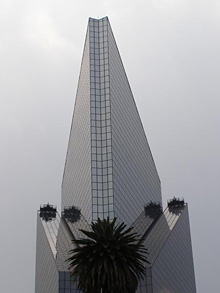 |
 |
 |
 Business News | January 2007 Business News | January 2007  
Good Times Foreseen for Mexican Stock Exchange
 Kenneth Emmond - MexiData.info Kenneth Emmond - MexiData.info


| | Mexican Stock Exchange |
Officials at the Mexican Securities Exchange (BMV) can join investors in enjoying a warm glow of satisfaction at the performance of its listed stocks during 2006.

The exchange’s Index of Prices and Quotations (IPC) closed out the year at an all-time high of 26,448.32.

It was the 61st all-time high registered during 2006. The year’s gain was 8,845.61 points, 48.56 percent above the Jan. 1, 2006 mark.

There was a midyear wobble when investors feared that the market-unfriendly Party of the Democratic Revolution (PRD) would win the presidential election. When the National Action Party (PAN) candidate, Felipe Calderon, eked out a victory the market hardly looked back.

The BMV has done some things right, but its managers must share credit for the up trend with growing investor confidence in emerging markets worldwide.

Globally, the value of emerging market shares passed US$2 trillion last year, quadruple that of 2002, according to the International Emerging Capital Markets Index of Morgan Stanley, an investment bank. The index includes the exchange-traded shares in 25 of the largest developing countries, including Mexico.

Equity underwriter Merrill Lynch estimates that emerging markets still comprise only about seven percent of world stock market values, although their companies account for nearly a quarter of world gross domestic product (GDP).

That means there’s more room for emerging market stocks to grow. A recent Merrill Lynch survey shows that most major investors still place only a small part of their funds in emerging markets.

That may change: as emerging economies continue to show stability, investors will likely increase their holdings. Increasingly, governments get their financing from debt markets instead of depending on the International Monetary Fund, which is a sort of lender of last resort.

Foreign direct investment (FDI) — foreign investment in bricks and mortar rather than in stocks — is another confidence indicator. In 2005 developing countries attracted a record US$334 billion in FDI.

Although the luck of the global market trend was on their side, BMV managers have also done some things to enhance Mexico’s position as a good place to buy stocks.

The most noteworthy was passage of the Securities Market Act (Ley de Mercados de Valores) almost exactly a year ago. Crafted with the help of market officials and people in the securities industry, it strengthens the BMV in two ways.

First, by tightening the requirements of accountability of listed companies it improved the credibility of listed companies, making them more attractive to minority shareholders.

Second, by amending the rules to make it easier for smaller companies to list their shares, it set the stage for broadening the market by expanding the number of companies traded, something the BMV hopes will happen over the next few years.

Last year the BMV signed an agreement with the Brazilian Stock Exchange that’s designed to make it easier for Brazilian investors to buy stocks on the Mexican exchange and vice-versa. That increases the number of potential buyers in both markets.

Investment rules by Mexican pension funds have changed, and their entry into the equities markets also increases the number of potential buyers.

Things also worked out well at the corporate level. A key indicator that stock-pickers use to evaluate a stock is the price-earnings ratio — the relationship between the price of a stock and its reported earnings.

If the ratio is high, investors tend to shy away unless convinced that even better times are ahead. Since earnings of many listed companies rose in 2006, stock prices can move higher while maintaining their price-earnings ratio.

Of course there’s always room for surprises in financial markets. Mexico’s 1994-95 peso crisis blindsided many optimists and depressed emerging markets around the world, as did the Asian crisis of 1997-98.

Events like this are increasingly less likely to happen. One reason for the 1995 financial bloodbath was that only a few government officials knew that Mexico was technically broke. Government disclosure rules have since been tightened, and it now must report its current account position every month.

Emotional markets, like the one during the run-up to the 2000 dot-com crash, will always be part of market psychology, but even then wise investors could see it coming in time to pull out.

The biggest cloud on Mexico’s investment horizon is the likelihood of economic slowdown in the United States. Still, so long as the BMV is well managed it will continue to gain respect and its managers will have reason to be proud of their performance.

Kenneth Emmond, an economist, market consultant and journalist who has lived in Mexico since 1995, is also a columnist with MexiData.info. He can be reached via e-mail at Kemmond00@yahoo.com. | 
 | |
 |



